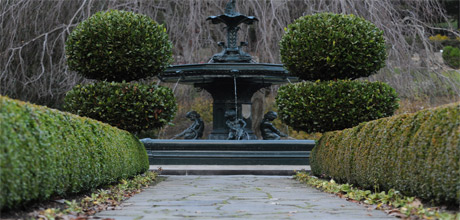Evergreen Topiary
This article was first published on 28 Jun 2011.

Evergreen Topiary
Topiary is the horticultural term used for the training of plants by clipping the foliage and stems of trees and shrubs to form and maintain clearly defined shapes.
The word topiary derives from the Greek word, topiarius, a landscape gardener, a creator of topia or places.
Plants typically used in topiary are evergreen and produce small, close knit leaves or needles and have a dense or columnar habit. The most common trees and shrubs used include yew (Taxus spp.) European box (Buxus sempervirens), bay laurel (Laurus nobilis), privet (Ligustrum spp.) and boxleaf honeysuckle (Lonicera nitida)
My love of topiary began when I was a student at Longwood Gardens, Pennsylvania, U S A. There is a stunning collection of yew trees, clipped into various magical shapes, including birds, a chair and table, cones, pyramids and spirals.
Here at Dunedin Botanic Garden there is a pair of bay laurel topiaries clipped into balls, at either end of the box hedges which lead from the Knot Garden to the Wolf Harris Fountain.
Topiary can be grown from cuttings or a plant specifically selected for the purpose. The most important part of growing topiary is the trimming or clipping. This requires a good eye and plenty of patience. The art of topiary is exciting and fun, as you see the forms and shapes develop. The best times to trim are early spring and late autumn, but will depend on the plants used and the age of the specimens.
Gordon Graham is a plant collection curator at Dunedin Botanic Garden.


